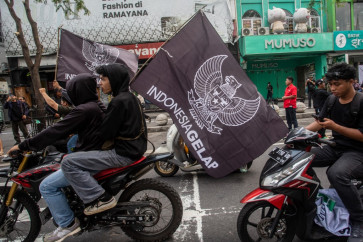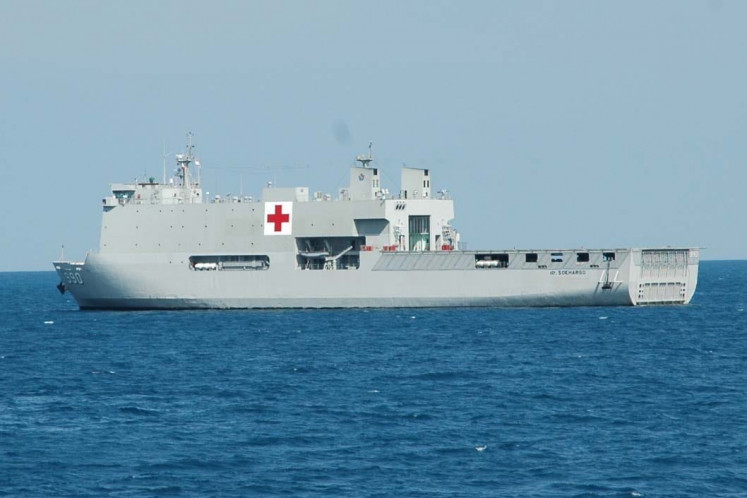Popular Reads
Top Results
Can't find what you're looking for?
View all search resultsPopular Reads
Top Results
Can't find what you're looking for?
View all search resultsSpecial report: The missing BRIC in Indonesia’s wall
The Dutch were the last to build a railway in Indonesia and that was before World War II
Change text size
Gift Premium Articles
to Anyone
T
he Dutch were the last to build a railway in Indonesia and that was before World War II. Their soldiers marched people off their land at gunpoint. The question of compensation did not arise.
Now, it’s the Chinese that are coming to build a new railway in Indonesia. China Railway Group has been awarded a US$4.8 billion contract to build and maintain the new line in southern Sumatra, which before Dutch colonial rule in the Indonesian archipelago was the centre of a Southeast Asian maritime empire that had thriving trade links with China, the Middle Kingdom.
The railway will run from the Tanjung Enim coal mine, the richest deposit in Indonesia, to a new port in the Sunda Strait, where what’s left of the Krakatau volcano still puffs smoke after blowing its top in 1883.
From there, the coal will be shipped to the northern hemisphere to power China’s industrial engine, part of a strategy of building infrastructure for resources that Beijing has employed successfully elsewhere in the world.
The quest is not as simple, or as brutal, as it was under colonial rule. Getting land, licenses and locals onboard requires a hearts-and-minds campaign and illustrates why, despite a return to investment grade, betting money on Southeast Asia’s biggest economy isn’t for the fainthearted.
Ratings agencies have been raising Indonesia’s credit rating at a time when they have been downgrading Western economies. On Wednesday, Moody’s Investors Service returned Indonesia to investment grade for the first time since the Asian financial crisis in 1997-98.
Indonesia needed an International Monetary Fund bailout to recover from that crisis, but it avoided tumbling along with the world’s largest economies and neighboring countries into a global recession in 2008-2009.
Now, helped by a global commodities boom, Indonesia is one of the fastest-growing countries in the G20, and could join Brazil, Russia, India and China — the BRIC economies — as the next emerging markets powerhouse. An estimated 35 million of its population of 240 million are now considered middle class.
Fitch Ratings brought Indonesia back to investment grade last month after 14 years of junk ratings, citing President Susilo Bambang Yudhoyono’s efforts to kick-start infrastructure.
A long-awaited land acquisition law was passed on Dec. 16, allowing Indonesia to accelerate road, port and airport projects, and could be a major turning point in the country’s efforts to ignite an economic boom.
Investors, hungry to dig into the archipelago’s vast deposits of oil, gas, and minerals, expect the land-acquisition law to spur government infrastructure projects. But it will be no help for private projects such as the Sumatra railway.
President Yudhoyono has pledged to double spending on roads, seaports and airports to $150 billion to help deliver average growth of 6.6 percent over the remainder of his term ending in 2014. Poor infrastructure is the biggest impediment to foreign direct investment and Yudhoyono hopes foreigners will pony up much of the money to improve it.
But Indonesia, which has had a feisty democracy since the fall of long-time autocrat Soeharto in 1998, remains a stubbornly difficult country in which to do business, and Yudhoyono may find it easier to raise that kind of money than to spend it.
In a country where property deeds can be as scarce as snow, getting land and local permits is likely to remain the biggest impediment to investment.
A Reuters examination of the railway project in Sumatra shows that investing in projects in the provinces has become much harder than during the Soeharto dictatorship, when Indonesia was last rated investment grade. Since then, Indonesia has decentralized much of its power. Now a myriad of local interests must be accommodated, inevitably causing delays.
That has been the case with the Sumatran railway, whose completion looks set to be pushed back at least three years to 2017, an executive at Indonesia’s Rajawali Group, which is the majority owner of the rail project, told Reuters.
Investors in the project have had to pay off gangs, build swimming pools for the government, step around delicate religious sensibilities and try to overcome years of mistrust from locals, such as Sigurung in the village of Tanjung Raja Giham.
Sigurung is a 70-year-old village elder. Like most Indonesians, he uses one name. Sigurung remembers how Dutch soldiers intimidated his grandparents, driving them off their land, halfway between the mine and port to build the old railway to the coal mine back in 1914. They shot some residents before forcibly relocating the rest.
Sigurung is fine with the latest rail project — as long as he gets paid for the land and his sons get jobs. Otherwise, there will be trouble, he vows.
“There will be no railway if you don’t get permission from us. The Chinese can work in this area as long as they’re nice to us. But if you don’t give us work we will become thugs,” he said with a disarming smile.
Indonesia lags its Southeast Asian neighbors in building highways, ports and power plants. The World Bank ranks it 75th on its Logistics Performance Index, well behind peers Thailand, the Philippines and Malaysia.
The 307-km Transpacific Railway runs from the coal mine to a new port near the provincial capital of Bandar Lampung on the Sunda Strait. The line would enable coal firm PT Bukit Asam to triple the output of its vast open-pit mine, under which lies enough coal to fuel China’s current imports for about 15 years.
The project, which took six years just to get off the ground, will likely be delayed because of an issue with its coal license. This may worry stock investors who paid a big premium for shares in Bukit Asam, betting the railway will turn a medium-sized producer into a global heavyweight alongside Indonesia’s Bumi Resources.
Chinese investors face their own host of issues in increasing exposure to the railway. With its banks financing the project, and China Railway building it, Chinese industry is expecting a huge bump in coal imports: as much as half the increased coal output is slated to go to China.
The Chinese have helped fund and build infrastructure projects in resource-rich countries from Myanmar to Zambia. But Indonesia has nursed a deep distrust of communism since a bloody, failed coup in 1965 by a pro-Beijing communist party, and populist resentment over local ethnic Chinese wealth.
“It’s very difficult for foreign investors, particularly from China, to get assets in Indonesia,” said Rudiantara, the chief of the development firm running the railway project, Bukit Asam TransPacific.
But with demand for investment growing, that may have begun to change. Indonesia is seeking $100 billion of private funding to overhaul its creaking transport network. Chinese Premier Wen Jiabao, on a visit to Jakarta last April, pledged $19 billion of investment credit for Indonesia, including $9 billion of soft and commercial loans for infrastructure development.
China Development Bank will lead the financing of the railway project, with money also coming from the world’s biggest and fourth biggest lenders, ICBC and Bank of China.
Despite the delays, Rudiantara said the coal railway could become a blueprint for future Chinese investment and private infrastructure projects in Indonesia, the world’s largest exporter of thermal coal.
Scribbling calculations and drawings on a giant whiteboard in the boardroom of his Jakarta office, he showed how the railway’s route will shave hours off coal delivery times and drive a surge in the mine’s output.
But he also acknowledged the challenges. “We call them the three Ls — licenses, land and loans,” Rudiantara said, adding he already had most of the licenses out of dozens needed from local and central government officials.
Indonesian bureaucracy has a reputation among foreign investors for being obstructive and corrupt. Even having local partners has not stopped many from pulling out of Indonesian projects to stem their losses.
“The issue is getting the right local partner,” Rudiantara said. “China feels ‘hey I have money, I have everything, you come to me, I’m not coming to you’ ... The relationship really matters when you’re dealing with the Chinese.”
Getting the money was the easy part for Rudiantara, who is teaching his daughter Mandarin and who has a dragon embossed on his business card. At a business lunch with Chinese bank representatives he once got 10 basis points off the cost of a loan by agreeing to go to Beijing and sing karaoke songs in Mandarin, a former colleague said.
Getting the land is the last and highest hurdle, Rudiantara said. Few people have land rights documents in an archipelago of 17,000 islands with hundreds of tribes and ethnic groups, and conflicting claims can turn violent.
In one case, the landowner had been travelling for years and couldn’t be reached, and for religious reasons his wife wouldn’t speak to men without the approval of her husband. It took Rudiantara several months to resolve the issue through negotiation with her male relatives. In another, the chief of a Sumatran district sold off a chunk of land that wasn’t his to a rival firm, leading to a drawn-out court battle that Bukit Asam lost.
Once a developer finds a landowner, negotiations over the acquisition price usually begin with only a vague sense of market value.
Rudiantara plans to swoop on the whole route at the same time with his team, to avoid the negotiations driving land price speculation further down the track. Prices of land along the route range from Rp 100,000 per square meter to Rp 1 million ($10 to $100), residents said.
“If there is not fair compensation there will be a riot and nobody will want to give up the land,” said Sigurung’s nephew Bumiputera, his comments incongruous with his sleepy village of ramshackle houses and rutted lanes 200 km from Bandar Lampung.
Rajawali Group has consulted universities on how best to approach local people from an ethno-cultural perspective. Its progress will be closely watched, given that many projects, such as another coal railway by Gulf-based investors MEC Holdings on Borneo island, have been held up for years over land acquisition. “This is a make-or-break infrastructure project for Indonesia,” Rudiantara said.
At Bukit Asam’s mine operations in Tanjung Enim, huge yellow dump-trucks trundle along giant open pits stretching to the horizon, where wild elephants and tigers roam in the island’s remaining jungles. From this smoldering, grim place, Bukit Asam’s former chief executive Sukrisno conducted a charm campaign with gift hampers of rice, sugar and cash for local residents.
Government officials are more costly. Sukrisno says the company refuses to give cash, but instead builds facilities, such as a Rp 29 billion ($300,000) hospital and tennis courts used for the recent Southeast Asian Games in the provincial capital of Palembang.
“In the past three years we spent Rp 35 billion ($3.8 million) to build a sports center in Muara Enim (town). Now they are asking for a swimming pool. I say ok, we’ll provide it. They are also asking us to build an education center,” he said.










